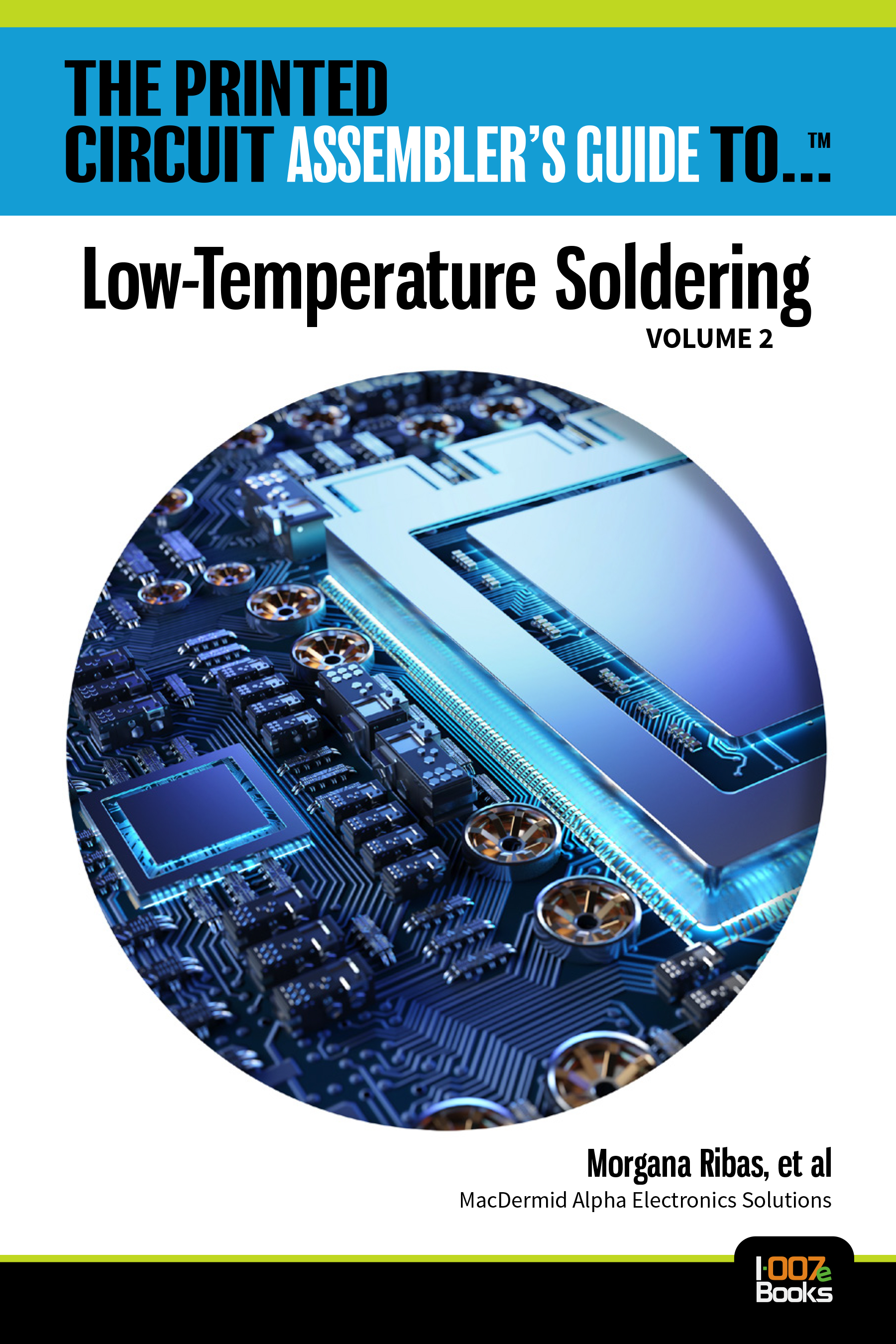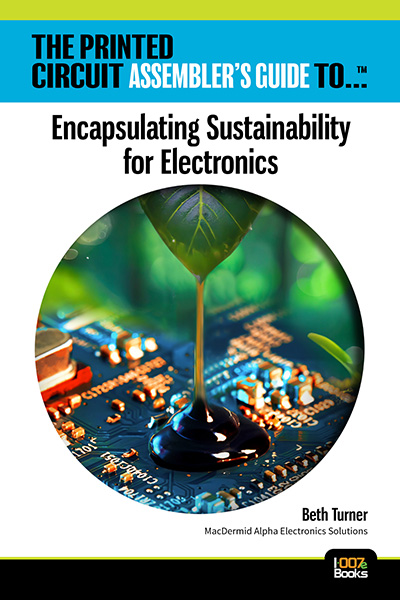-

- News
- Books
Featured Books
- smt007 Magazine
Latest Issues
Current Issue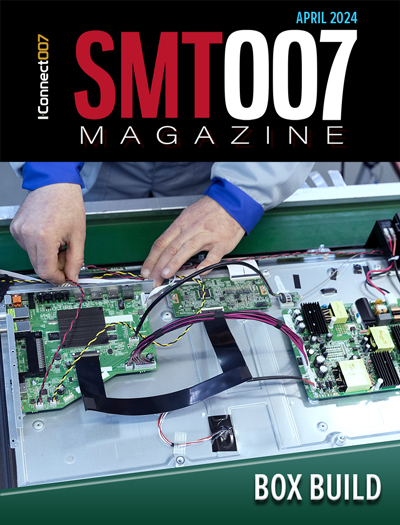
Box Build
One trend is to add box build and final assembly to your product offering. In this issue, we explore the opportunities and risks of adding system assembly to your service portfolio.
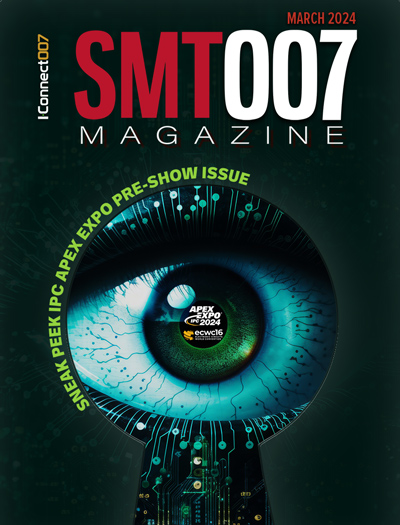
IPC APEX EXPO 2024 Pre-show
This month’s issue devotes its pages to a comprehensive preview of the IPC APEX EXPO 2024 event. Whether your role is technical or business, if you're new-to-the-industry or seasoned veteran, you'll find value throughout this program.
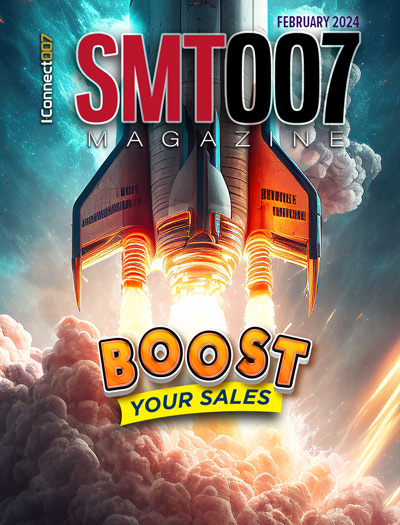
Boost Your Sales
Every part of your business can be evaluated as a process, including your sales funnel. Optimizing your selling process requires a coordinated effort between marketing and sales. In this issue, industry experts in marketing and sales offer their best advice on how to boost your sales efforts.
- Articles
- Columns
Search Console
- Links
- Events
||| MENU - smt007 Magazine
Latest Articles
Crowded Congressional Calendar Affects Industry Priorities
More than five months remain in 2019, but U.S. congressional leaders are already running out of time as they face a long list of must-pass bills before year’s end. Although some of these bills do not affect the electronics industry, some of them do, and the overall agenda does affect the opportunities and risks we face.
The Four Things You Need to Know About Test
The electronics manufacturing process can often be extremely complex, and the costs associated with product recalls can be astronomical. A robust approach to test is key to ensuring the quality of your product and the satisfaction of your end user.
A Conversation with Karen McConnell—An Emerging Engineer Program Mentor
IPC’s Emerging Engineer program, launched in 2016, provides early career professionals an opportunity to learn from dedicated industry volunteers who participate in IPC standards development. IPC’s editorial staff had the opportunity to talk with one of those dedicated volunteers, mentor Karen McConnell, Senior Staff Engineer CAD CAM, Northrop Grumman, about why she participates as a mentor in IPC’s Emerging Engineer program.
Optimizing Solder Paste Volume for Low-Temperature Reflow of BGA Packages
In this article, Keith Sweatman explains how the volume of low-melting-point alloy paste—which delivers the optimum proportion of retained ball alloy for a particular reflow temperature—can be determined by reference to the phase diagrams of the ball and paste alloys.
Approaches to Overcome Nodules and Scratches on Wire-Bondable Plating on PCBs
Initially adopted internal specifications for acceptance of printed circuit boards (PCBs) used for wire bonding was that there were no nodules or scratches allowed on the wirebond pads when inspected under 20X magnification. This paper details if wire bonding could be successfully performed over nodules and scratches and if there was a dimensional threshold where wire bonding could be successful.
Practical Implementation of Assembly Processes for Low Melting Point Solder Pastes (Part 1)
Since 2006 and the implementation of the RoHS directive, the interest in bismuth-tin solder alloys—whose melting point around 140°C is very desirable because it allows for the use of lower temperature laminate materials and reduces thermal stress on sensitive components—has only increased as the industry has searched for Pb-free alternatives to the chosen standard, SAC305, which melts at considerably higher temperatures than the incumbent tin-lead alloys.
Surface Treatment Enabling Low-Temperature Soldering to Aluminum
An increasingly popular method to meet the need for lower cost circuitry is the use of aluminum on polyester (Al-PET) substrates. This material is gaining popularity and has found wide use in RFID tags, low-cost LED lighting, and other single-layer circuits. However, both aluminum and PET have their own constraints and require special processing to make finished circuits.
Dissecting the IPC Regional Survey on PCB Technology Trends
Sharon Starr, Denny Fritz, and Mike Carano talk about the global 2018 IPC Technology Trends Report released early this year—the size of the survey, how it was conducted, the general findings, and regional differences. They also shared their takeaways and regional insights, and the industry outlook over the next five to 10 years.
ICT or Flying Probe: Which Test Is Best for Your Assembly?
In-circuit test (ICT) and flying probe are two of the most popular types of automated test equipment (ATE) used in electronic printed circuit board assembly (PCBA).
Failures and Reliability in Soldering
The definition of failure is "the lack of success in doing or achieving something, especially in relation to a particular activity." If the activity is concerning a soldering process, such a failure can have a downstream impact far beyond the actual solder joint. In this regard, it is first necessary to understand what constitutes a good solder joint because appearance is too often deemed a success.
Size Matters: The Effects of Solder Powder Size on Solder Paste Performance
Solder powder size is a popular topic in the electronics industry due to the continuing trend of miniaturization of electronics. And the question commonly asked is, "When should we switch from Type 3 to a smaller solder powder?" Read more to find out.
Low-Temperature SMT Solder Evaluation
Until recently, the use of Sn/Bi-based SMT solder materials has been investigated with negative consequences for high strain rate (drop-shock) applications; thus, these alloys have been avoided. Recent advances in alloy 'doping' have opened the door to revisit Sn/Bi alloys as a possible alternative to SAC-305 for many applications.
Cavity Board SMT Assembly Challenges (Part 2)
This article describes the details of a study of assembling SiP BGA packages into a cavity. It points out the challenges involved in the board cavity design and assembly of components in a cavity. The authors discussed the board design challenge of having a cavity and defining the proper depth of the cavity to accommodate the board fabricator, the product design, and the SMT assembly.
Clean vs. No-clean Solder Process
Although IPC suggests clear guidelines, agreeing on the cleanliness (or otherwise) of a PCB assembly can often be a subjective and even contentious subject within the electronics manufacturing industry. If you’ve chosen to outsource your assemblies, how do you decide what to specify to your EMS partner? Find out here.
Smart Manufacturing Roadmap: Data Flow Considerations for the Electronics Manufacturing Industry
The 2019 iNEMI Roadmap features a new chapter on smart manufacturing. The chapter identifies key technology gaps and needs and offers recommendations to guide the electronics manufacturing industry in realizing the benefits of smart manufacturing. This article is based on information excerpted from the chapter.
Reliability vs. Failure
Summer is officially underway here in the Northern Hemisphere, and just like the temperatures, we’re turning up the heat in this issue and getting technical. Enter “Reliability Man,” the hero who must persevere against all the challenges thrown in his path.
Digitalization: Key to the Future of Electronics Manufacturing?
Electronics manufacturers have long relied on automation to streamline their production processes. The concept of the smart factory takes this one step further with artificial intelligence (AI), robotics, analytics, big data, and the Internet of Things (IoT) promising an even greater level of autonomy, agility, and connectivity.
Saying Yes to Opportunities: IPC’s Emerging Engineer Program Offers Career Growth for Electronics Industry Newcomers
What makes the IPC Emerging Engineer Program a premier networking and career enriching program? IPC staff spoke to Emerging Engineer Kate Stees, materials and process engineer, Lockheed Martin, about her experience in the program and why she recommends it to other engineers.
Words of Advice: Making Life Easier for Fabrication and Assembly
In a recent survey, we asked the following question: What steps do you take to make the job easier for your fabrication and assembly providers? Here are a few of the answers, edited slightly for clarity.
Albert Gaines: Design All Comes Down to Documentation
During SMTA Atlanta, I spoke with Albert Gaines of HiGain Design. We discussed Albert’s belief that everything starts with design and that too many engineers and designers focus solely on the final board at the expense of the documentation, which is a designer’s most important product. Do you consider your documentation to be a critical product?
IPC SummerCom Highlights: A Government Relations Perspective
Last week, IPC hosted SummerCom, our semi-annual standards development committee meetings, in Raleigh, North Carolina. The event brought together thousands of technical experts from around the world to shape the product, manufacturing, and supply-chain standards that guide our industry.
Cavity Board SMT Assembly Challenges (Part 1)
The concept behind Component-in-Cavity (CiC) is straightforward. If the tallest component(s) on the motherboard can be placed into a recession created in the motherboard, their thickness relative to the components on the surface of the PCB will thus effectively be reduced. While this concept may be straightforward, its implementation is not. That implementation is the focus of this paper. Read on.
3D Optical Inspection Provides ‘Eyes’ for Process Improvements in Industry 4.0
Automated 3D solder paste inspection (SPI) and 3D automated optical inspection (AOI) systems have become an integral part of the printed circuit board assembly (PCBA) process because they help ensure high-quality production. As today’s board complexity is increasing, inspection technology has become even more critical.
AWE 2019: Go XR, Be Awesome
Dan Feinberg attended and covered the recent 2019 Augmented World Expo (AWE) and conference in Santa Clara, California. The event featured the latest developments and technologies in augmented (AR), mixed (MR), virtual (VR), and extended virtual reality (many just call it all XR to make it simple). Here's a wrap-up of the event.
Goepel electronic Solutions, Webinar Series, and Trends
Barry Matties catches up with Matthias Müller to chat about the wide range of test and inspection solutions currently being offered by Goepel electronic as well as the informative webinar series produced by the company to help further educate their customer base and promote technical discussion on a number of topics.
Here's What You Need When Outsourcing Box Build Assembly
Box build, or top-level assembly, can be less well-defined. A box build can mean many things—from a PCBA in a small enclosure to a large cabinet full of wires or a complex fully integrated electromechanical system with electronics and pneumatics. Here's what you will need to consider to get an accurate quote and help the build process go smoothly with your EMS partner.
Data: Key to Automating Right the First Time
Michael Ford, senior director of emerging industry strategy, reflects on his first two years with Aegis Software Corporation and looks to the future of the data-driven manufacturing environment. Michael shares how the CFX and data collection model can play an important role in the streamlining processes, including Industry 4.0 and the supply chain.
The Effectiveness of 75% IPA/25% DI Extraction Solution on No-clean Flux Residues
The continuous challenge in the electronics industry is to keep up with the demand for smaller, faster, and more reliable electronics. When it comes to cleaning, this rapid development of manufacturing and reliability challenges is juxtaposed with the slow pace of new test method development.
What Electronics Companies Need to Know About Environmental Product Requirements
The task of monitoring and complying with environmental, health and safety (EHS) rules that affect electronics companies and their products requires a watchful eye on all levels of government: local, state, national, and international.
Reflow Your Solder and Your Data for Industry 4.0
I-Connect007 Managing Editor Nolan Johnson recently spoke with KIC President and Founder Phil Kazmierowicz and Manager of Applications and Sales MB “Marybeth” Allen as they each transitioned into new roles in the KIC leadership team. The conversation ultimately turned to the current dynamics in the industry, particularly Industry 4.0 and streamlining processes.
IPC’s PCB Tech Trends Study Highlights Issues Impacting Fabricators
The 2018 survey results indicated the need for speed and low loss as critical functions of the materials chosen. This is the digital age, and with the Internet of Things, virtual and augmented reality, vehicle-to-vehicle communication, etc., the need for low-loss and ultra-low-loss materials continues to grow as a percentage of circuit boards fabricated.
Laserssel Brings High-speed Soldering to New Application Areas
In this interview with I-Connect007, Denis Barbini, general manager of Laserssel, talks about the company's new laser-selective reflow solution aimed at reducing a typical reflow oven’s 10-minute cycle down to just 10 seconds as well as the overall benefits manufacturers could see from streamlining this process.
4 Key Considerations When Auditing a New EMS Partner
Choosing whether (or not) to outsource your electronics manufacturing is likely to bring with it a multitude of questions—and some understandable doubts. Outsourcing is a critical decision—and it’s one that will rely on thorough research, close examination and the asking of some tough questions. This article summarizes four key areas that you'll want to scrutinize as you embark on your supplier selection process.
Minimizing Voids in Solder Joints
Dr. Hans Bell of Rehm Thermal Systems, Henryk Maschotta of Thales Deutschland GmbH, and Dr. Heinz Wohlrabe of TU Dresden presented the results of their project on reducing void content in the solder joints of land grid arrays (LGAs) at a soldering seminar during the Technology Days of the recent SMTconnect show in Nuremberg.
Words of Advice: Planning a New Design
In a recent survey, we asked the following question: What do you think is the most important thing a designer should remember when planning a new PCB design? Here are a few of the answers, edited slightly for clarity.
PCB Fabricators’ Tech Capabilities Exceed OEMs’ Needs in Many Areas
Some interesting differences showed up in the board property data reported by the OEMs and PCB fabricators that participated in IPC’s PCB Technology Trends 2018 study.
Synergy Between Smart Manufacturing and the Secure Supply Chain (Part 2)
With the trend of shortening lead-times within the material ordering process, and the frequency with which urgent orders for materials from the grey market are made, there is increased opportunity for the ingress of counterfeit materials. The situation is made far worse when a genuine shortage of materials in the supply chain occurs. The consequences of not being able to eliminate the risk of defects getting through into the market will be disastrous for individuals as well as for the company brand image, not to mention the associated costs of recovery. It is only a matter of time, unless something very significant changes.
Smart Factory Transitions Are Attainable—With a Plan
In a white paper, Zac Elliott, technical marketing engineer at Mentor, a Siemens company, outlines a structured organization for smart factory implementation. While there can be one set of challenges to overcome when building a smart factory on a greenfield site, firms restricted to pre-existing facilities face a different set of hurdles. In this interview, Elliott discusses how things have proceeded since the paper was published, and talks about strategies for smaller firms and brownfield companies.
Streamlining, but Streamlining What?
Electronics continue to grow in application areas, capabilities, and complexities. With such growth in the raw number of circuit boards being produced globally, the pressure is on to build more faster with higher quality and greater reliability. But this isn't new. What is new is the thinking and problem-solving that will need to happen at the manufacturing floor level to deliver on this coming need.
The GraftWorx Fluid Management Patch Story
The GraftWorx vision is to connect patients to clinicians with clinical data that will have a meaningful impact on their care. Its first application is to monitor patients with end-stage renal disease or kidney failure using a wearable device called the SmartPatch that records numerous clinical cardiovascular metrics. This article details how GraftWorx was designed, fabricated, and assembled.
Synergy Between Smart Manufacturing and the Secure Supply Chain (Part 1)
As MRP and ERP functions follow computing trends and start to migrate into the cloud, a fundamental question is being raised as to whether these are still the right tools to use in today’s modern Industry 4.0 driven factory, or whether these need to evolve, be enhanced, or even replaced in order to meet the more extreme requirements of operational flexibility, as well as cope with volatile material availability in the market.
Collaboratively Creating Wearable Medical Products
Patty Goldman, Barry Matties, and Happy Holden recently spoke with David Moody and Rich Clemente of Lenthor Engineering along with Anthony Flattery and Amit Rushi—their customers at GraftWorx. They discussed a recent project and how they worked together to solve a difficult problem by designing a rigidized flex circuit for their product.
4 Ways Electronics Manufacturers are Growing Their Businesses in 2019
At a time when many manufacturers are struggling to remain profitable, and with the uncertainty of the Brexit negotiations still looming large, finding new ways to nurture and grow your electronics manufacturing business has never been more crucial. Yet, despite the current challenges, some EMS providers are bucking the trend with reports of sustained growth. Here is their secret.
Whizz Systems on Knowing Your Strengths and Building Customer Relationships
Located in the heart of the Silicon Valley, Whizz Systems Inc. provides electronics product design, development and manufacturing services. Muhammed Irfan, president of the company, speaks with Nolan Johnson about knowing your strengths, engaging start-ups, and building strong customer relationships through education and preparation.
Are Regional Differences in PCB Technology as Great as We Think?
We keep hearing that Asia is all consumer and automotive electronics and North America and Europe are all high reliability/long life. The findings in IPC’s PCB Technology Trends 2018 study show that these regions are not as different as expected, and the differences we do see are interesting.
Co-owner Philip Kazmierowicz on New Role as KIC President
KIC is one of the leaders in reflow and thermal process control and smart oven technologies. On March 25, 2019, KIC announced that Philip Kazmierowicz, company co-owner, would take on the position of president. Nolan Johnson took that opportunity to sit down with Kazmierowicz in his Oregon-based R&D lab to discuss KIC's history and his plans for the future of the company.
Communication and Information: Two Keys to Success
Nolan Johnson and Duane Benson, an I-Connect007 columnist and a representative from Milwaukee Electronics, discuss how assemblers can help their customers through submitting and maintaining accurate information, and engaging in open communication early and often about the highly important bill of materials.
Green Circuits' Three Tips to Be a Well-prepared Customer
Nolan Johnson speaks with Joe Garcia, VP of sales and marketing at Green Circuits, about how they can help on both the front and back end of the process, their hidden gem—design services—as well as three tips to be a well-prepared customer.
From DataED’s NPI Center to the Manufacturing Floor
The I-Connecct007 team recently spoke with a team of technologists and managers at Data Electronic Devices (DataED). Jeff Hamlett, director of sales and marketing; Lori Giglio, general manager at the NPI Engineering Center; Vic Giglio, president and CEO; and Ron Sprizza, VP of quality for DataED, provided an overview of the importance of company culture and making your customers the first priority.
Five Key Components of an NPI Report
An NPI report is an opportunity for your contract manufacturer to highlight any outstanding issues that will need to be addressed for future builds. The information that your EMS partner provides can play a pivotal role in ensuring that they continue to deliver your products on time, within budget, and to the highest quality standards.
Incoming CEO Steve Pudles on the Acquisition of Zentech
Nolan Johnson talks to Steve Pudles about the recent acquisition of Zentech Manufacturing Inc. by BlackBern Partners LLC and Zentech management. Steve, also an investor in Zentech, steps in as the incoming CEO of the new organization and discusses the deal, his new role, changes to management, and the company's plans post-sale.
XNC Format: Gerber Takes Data Into the Future
The problem is that so many NC files are of deplorable quality because the NC format was never designed as a data transfer format. It has always been a machine driver and contains all sorts of information that a drilling machine needs, but that is irrelevant and confusing for data exchange.
The One Thing
The vast majority of the problems that we run into fall to the categories of communication and information. As with the old 'telephone game,' each time information goes from one party to another, the risk of misinterpretation increases. If we are given unclear information from a customer, we may not be able to give the right information to our partner.
Smart Design Data Is Essential for Industry 4.0 Manufacturing
Almost all of the conversation regarding Industry 4.0 is centered on the manufacturing floor, which is where the effect of the initiative is most felt initially. Little attention is given to the starting data for manufacturing—the data that comes from design. However, you can’t have smart manufacturing if your process begins with dumb data. As Pink Floyd said, “You can’t have your pudding if you don’t eat your meat!”
Five Key Questions Your EMS Partner Should Be Asking in the Supplier Selection Process
As we've continued to observe the impact of the ongoing global electronics components shortage, any challenge to the supply chain has the potential to cause major disruption. Whether you currently manage your own end-to-end electronics manufacturing, or you have opted to outsource to an EMS provider, there are five essential issues (and potential risks) to bear in mind when assessing the value and reliability of any proposed new supplier.
Export Controls in Flux
U.S. export control rules have changed significantly over the last decade, and more changes are expected as policymakers tackle the treatment of new and foundational technologies and respond to geopolitical developments.
Impact of Stencil Foil Type on Solder Paste Transfer Efficiency for Laser-cut SMT Stencils (Part 2)
In the first part of this two-part article, Greg Smith talks about a study wherein a test vehicle was created to show transfer efficiency over a wide array of area ratios. Part 2 discusses the results of the experiment, including discussions of the different SEM results featuring the paste transfer efficiencies of each material, to better understand how the aperture wall surface smoothness compares to SMT stencil performance.
Catching up With Darrel Yarbrough of YES
Yarbrough Electronic Sales (YES) is one of the fastest growing contract manufacturers in the Southwest. As people get to know them better, they are becoming the go-to company in their area. In this interview, long-time industry veteran Darrel Yarbrough, owner of YES, provides a background about the company, its capabilities, and his outlook for the industry.
The Perfect Job
After all the days and weeks invested into developing the schematic, the PCB design, poring over the data sheets and online libraries for component parts, and running the calculations for mechanical clearances inside the enclosure, you—designers—are ready to be done. You're ready for the next design challenge—not for a week or so perfecting the bill of materials and the design notes. And there's the rub. Find out why.
Zentech's Mission-critical Tips for Program Success
Nolan Johnson and John Vaughan, I-Connect007 columnist and VP of sales and marketing at Zentech Manufacturing, discuss how to make customer programs successful through early communication, complete design packages, and more from a company servicing mission- and life-critical industries, including military, aerospace, and medical.
- 1
- 2
- 3
- 4
- 5
- 6
- 7
- 8
- 9
- 10
- 11
- 12
- 13
- 14
- 15
- 16
- 17
- 18
- 19
- 20
- 21
- 22
- 23
- 24
- 25
- 26
- 27
- 28
- 29
- 30
- 31
- 32
- 33
- 34
- 35
- 36
- 37
- 38
- 39
- 40
- 41
- 42
- 43
- 44
- 45
- 46
- 47
- 48
- 49
- 50
- 51
- 52
- 53
- 54
- 55
- 56
- 57
- 58
- 59
- 60
- 61
- 62
- 63
- 64
- 65
- 66
- 67
- 68
- 69
- 70
- 71
- 72
- 73
- 74
- 75
- 76
- 77
- 78
- 79
- 80
- 81
- 82
- 83
- 84
- 85
- 86
- 87
- 88
- 89
- 90
- 91
- 92
- 93
- 94
- 95
- 96
- 97
- 98
- 99
- 100
- 101
- 102
- 103
- 104
- 105
- 106
- 107
- 108
- 109
- 110
- 111
- 112
- 113
- 114
- 115
- 116
- 117
- 118
- 119
- 120
- 121
- 122
- 123
- 124
- 125
- 126
- 127
- 128
- 129
- 130
- 131
- 132
- 133
- 134
- 135
- 136
- 137
- 138
- 139
- 140
- 141
- 142
- 143
- 144
- 145
- 146
- 147
- 148
- 149
- 150
- 151
- 152
- 153
- 154
- 155
- 156
- 157
- 158
- 159
- 160
- 161
- 162
- 163
- 164
- 165
- 166
- 167
- 168
- 169
- 170
- 171
- 172
- 173
- 174
- 175
- 176
- 177
- 178
- 179
- 180
- 181
- 182
- 183
- 184
- 185
- 186
- 187
- 188
- 189
- 190
- 191
- 192
Copyright © 2024 I-Connect007 | IPC Publishing Group Inc. All rights reserved.
Log in
